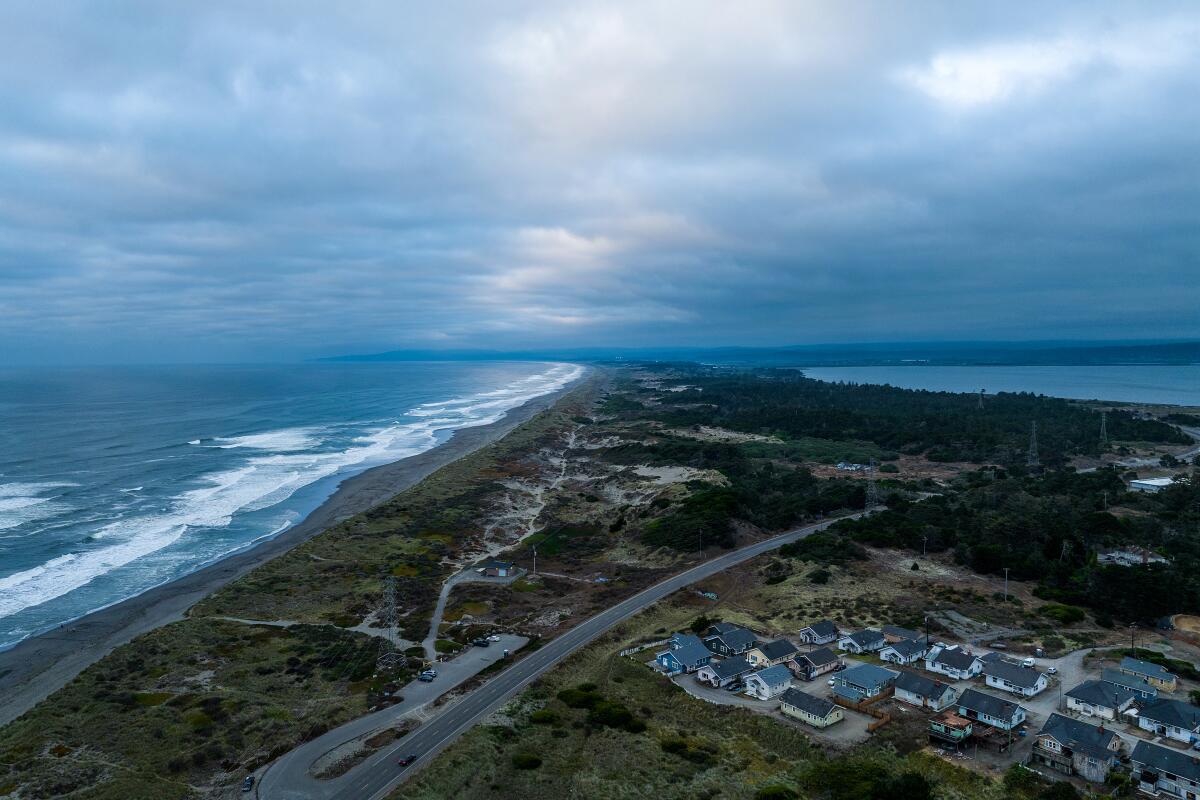Eureka, Humboldt County
The major city on California’s north coast, with a population of about 30,000
Climate: 0 annual days above 100 degrees expected, 2035-2064 (1st percentile of 367 cities)
Health and wellness: Ranks around average (top 50% of all cities) in the health index
Recreation: Above average (top 20%) in number of parks per capita
Affordability: Typical home value: $419,000 (8th percentile); typical rent for a single -family residence: $1,516 (3rd percentile)
Arcata, Humboldt County
A smaller college town a few miles from Eureka, home to Cal Poly Humboldt
Climate: 0 annual days above 100 degrees expected
Health and wellness: Above average (top 40% of all cities) in health index
Recreation: Excellent (top 10%) in parks per capita
Affordability: Typical home value: $510,000; typical rent: $1,700
-
PROS: Coastal location, cooler temperatures, relatively affordable housing, close to breathtaking nature and beaches.
CONS: Far from any big cities. A drive from Los Angeles would take nearly 11 hours, and that is without any traffic (good luck with that!).

The Samoa Peninsula in Eureka chills in drizzle and fog as the rest of the state swelters.
(Myung J. Chun/Los Angeles Times)
Benicia, Solano County
An exurb along the Carquinez Strait nestled in the outer Bay Area
Climate: 11 annual days above 100 degrees expected
Health and wellness: Excellent (top 10% of all cities) in health index
Recreation: Excellent (top 10%) in parks per capita
Affordability: Typical home value: $820,000; typical rent: $2,406
PROS: Moderate climate, access to wilderness and the San Joaquin river, and relatively close to Bay Area population centers.
CONS: Traffic, adjacent to sky-high Bay Area housing and living costs.
Big Bear Lake, San Bernardino County
A mountain resort town within a relatively short drive of Los Angeles
Climate: 0 annual days above 100 degrees expected
Health and wellness: Above average (top 40% of all cities) in health index
Recreation: Average (top 50%) in parks per capita
Affordability: Typical home value: $587,000; typical rent: $2,000
PROS: Glorious mountain location, perfect for hikes, water sports and skiing. Alpine feel but less than an hour to suburbia and less than two hours from Los Angeles.
CONS: May be a bit isolated, especially to those who move to homes outside of downtown Big Bear. Snow storms, mudslides and wildfires are a constant danger.
Signal Hill, Los Angeles County
A hilly, 2.2 square mile town of 11,000 residents, surrounded by the city of Long Beach
Climate: 4 annual days above 100 degrees expected
Health and wellness: Above average (top 40% of all cities) in health index
Recreation: Excellent (top 10%) in parks per capita
Affordability: Typical home value: $792,000; typical rent: $2,082
PROS: Central location, great views of the harbor and city, and close to Southern California’s urban attractions.
CONS: Small, compact location amid urban and industrial traffic.
Fair Oaks, Sacramento County
A tony Sacramento suburb overlooking the American River and parkland
Climate: 56 annual days above 100 degrees expected
Health and wellness: Very good (top 15% of all cities) in health index
Recreation: Good (top 40%) in parks per capita
Affordability: Typical home value: $616,000; typical rent: $1,992
PROS: Access to nature with nearby Sacramento river, plenty of open space and parks.
CONS: Exposure to extreme heat with changing climate, relatively expensive for the area.
Crescent City, Del Norte County
The last major California coastal city before hitting Oregeon
Climate: 0 annual days above 100 degrees expected
Health and wellness: Poor (bottom 20% of all cities) in health index
Recreation: Good (top 40%) in parks per capita
Affordability: Typical home value: $361,000; typical rent: $1,500
PROS: Much lower cost of living than most California cities, easy access to redwood forests and the Pacific Ocean.
CONS: Extremely remote by California standards, with few attractions compared to most urban and suburban areas. Faces seismic and tsunami danger.
Grass Valley, Nevada County
A Sierra mountain town with Gold Rush history, long a popular retirement destination
Climate: 19 annual days above 100 degrees expected
Health and wellness: Below average (bottom 40% of all cities) in health index
Recreation: Around average (top 50%) in parks per capita
Affordability: Typical home value: $516,000; typical rent: $1,737
PROS: Great location for hiking, skiing, camping, history, and proximity to Lake Tahoe.
CONS: Cold, snowy winters (though some retirees prefer such conditions), and long distance from major cities. Fire danger
Emeryville, Alameda County
The city between the Bay Bridge and Oakland has a suburban feel
Climate: 1 annual day above 100 degrees expected
Health and wellness: Excellent (top 10% of all cities) in health index
Recreation: Excellent (top 10%) in parks per capita
Affordability: Typical home value: $524,000; typical rent: $2,935
PROS: Proximity to population centers and workable public transit and access to San Francisco Bay.
CONS: Often foggy, windy and cold, with exposure to Bay Area cost of living.
Belmont, San Mateo County
A small Silicon Valley/Peninsula suburb with superb ratings on health and quality of life factors
Climate: 2 annual days above 100 degrees expected
Health and wellness: Stellar (top 5% of all cities) in health index
Recreation: Very good (top 15%) in parks per capita
Affordability: Typical home value: $2,145,000; typical rent: $2,731
PROS: Access to Bay Area cities, excellent quality of life metrics such as schools and health care. Close to San Francisco airport.
CONS: High cost, and exposure to Silicon Valley traffic.
Deciding on the best retirement destinations in California is a subjective and possibly foolhardy exercise. This analysis assumes that practical factors like affordability are most salient, and that less tangible factors like culture or entertainment are less important. Still, this ranking takes all of those factors into consideration.
The bottom five cities were mostly in Southern California, with high housing costs, far too expensive for a typical California retiree.
